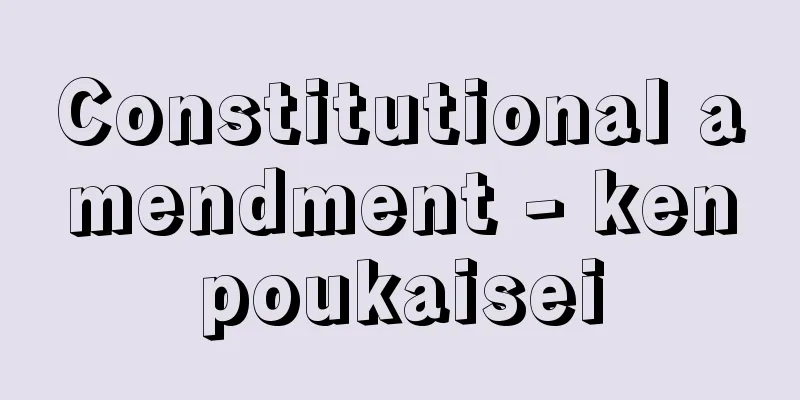Constitutional amendment - kenpoukaisei

|
The amendment of the provisions of a written constitution through a set procedure. There are full amendments, where the constitution is completely rewritten, and partial amendments, where parts are revised by amending, deleting, adding, or supplementing clauses. Amendments to the United States Constitution are made by adding new clauses, including those that contradict existing provisions, without making any changes to the existing text. Amendments are distinguished from constitutional changes, where the meaning of the constitution is changed by custom, in that the text is consciously changed. There are flexible constitutions, where amendments can be made through normal legislative procedures, and rigid constitutions, where amendments are made through stricter procedures than normal legislative procedures, and most constitutions today are rigid constitutions. Article 96, paragraph 1 of the Constitution of Japan stipulates that constitutional amendments must be proposed by the Diet with the approval of more than two-thirds of the total members of the House of Representatives and the House of Councillors, and must further receive the approval of a majority in a special national referendum or a vote held during an election determined by the Diet. With regard to the question of what kind of amendments are possible based on the prescribed amendment procedures and whether there are limits, opinions are divided between the limit theory and the unlimited theory, but the limit theory is predominant. The Constitution of Japan was established as an amendment to the Constitution of the Empire of Japan, but it is generally interpreted as the establishment of a new constitution because it changes the location of sovereignty. Since the Constitution of Japan was created based on the MacArthur Draft drafted by the General Headquarters of the Allied Powers (GHQ), the merits of constitutional amendment became a major political issue in postwar Japan. In 2007, the Act on the Amendment Procedures of the Constitution of Japan (National Referendum Act) was enacted and came into effect in 2010, concretely defining the procedures for constitutional amendment that had not previously been stipulated. (→Constitution) Source: Encyclopaedia Britannica Concise Encyclopedia About Encyclopaedia Britannica Concise Encyclopedia Information |
|
成文憲法の条文を,所定の手続きをふんで改変すること。憲法を全面的に書き改める全部改正と,条項の修正,削除,追加または増補によって一部を手直しする部分改正がある。アメリカ合衆国憲法の改正は,既存の憲法典になんら変更を加えず,従来の規定と矛盾するものも含め,新しい条項を付加していくという方法で行なわれる。その明文を意識的に改変するという点で,慣習によって憲法の意味を変える憲法の変遷と区別される。改正が通常の立法手続でできる軟性憲法と,改正が通常の立法手続より厳格な硬性憲法があり,今日ほとんどの憲法が硬性憲法である。 日本国憲法96条1項は,憲法改正は衆議院と参議院の総議員の 3分の2以上の賛成で国会が発議し,さらに特別の国民投票または国会の定める選挙の際行なわれる投票において過半数の賛成を得なければならないと定めている。所定の改正手続に基づけばどのような改正も可能であるのか,限界はあるのかという問題に関しては,限界説と無限界説に見解が分かれるが,限界説が支配的である。日本国憲法は大日本帝国憲法の改正として定められたが,主権の所在を変更しているなどの点から,新憲法の制定と一般に解されている。日本国憲法が,連合国総司令部 GHQによって起草されたマッカーサー草案に依拠してつくられたということもあり,憲法改正の是非は戦後日本における大きな政治問題となった。2007年には日本国憲法の改正手続に関する法律(国民投票法)が成立,2010年に施行され,従来規定されていなかった憲法改正の手続きが具体的に定められた。(→憲法) 出典 ブリタニカ国際大百科事典 小項目事典ブリタニカ国際大百科事典 小項目事典について 情報 |
<<: Constitutional interpretation - Kenpougige
Recommend
Ibn Yunus
?‐1009 Arab astronomer. He conducted observations ...
sacrum consistorium
...the empire was completely transformed from a p...
Onjogadani Tile Kiln - Onjogadani Tile Kiln
…a kiln built on the ground to bake tiles made fr...
relative index of refraction
...The angle between the normal to the boundary s...
Anchusa (English spelling) bugloss
A biennial plant of the family Violaceae, with 30 ...
Maypole
...The Kabbalistic tree was passed down to mystic...
Sao people - Sao (English spelling)
A tribe that lived from the 10th century to the 16...
Kokei Sochin
1532-1597 A monk from the Sengoku to Azuchi-Momoy...
Conrad discontinuity
At the boundary between granite and basalt layers ...
Ministry of Finance Securities - Okura Shoshoken
Also called "kuraken." Short-term govern...
Prayer plant
...It is a perennial plant with about 23 species ...
Certificate of Secondary Education
...Today, the pass rate for the baccalauréat is 7...
Angelico (English spelling) Angelico, Fra; Fra Giovanni da Fiesole
[Born] Around 14:00. Bikkio Died: February 18, 145...
Porgy and Bess
An opera composed by Gershwin. Set in the black ne...
Hayashi Yuteki
Year of death: February 18, 1901 (Meiji 34) Year o...









